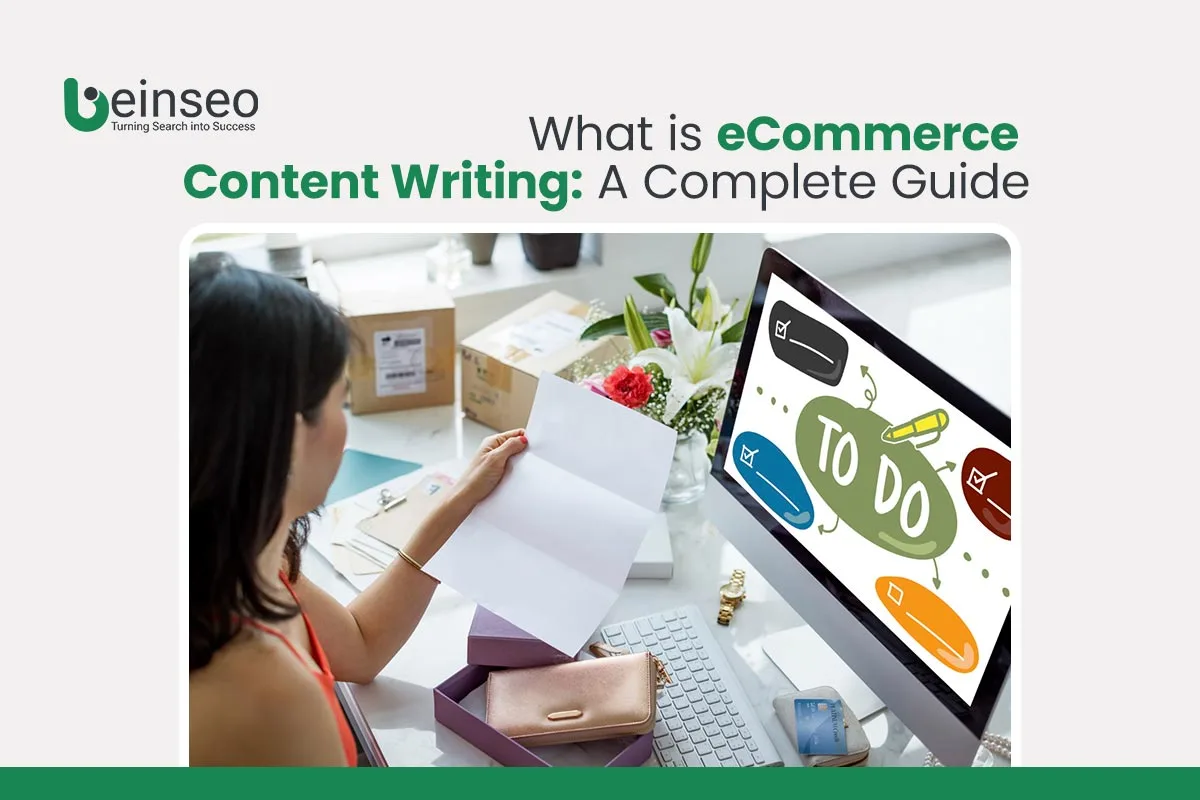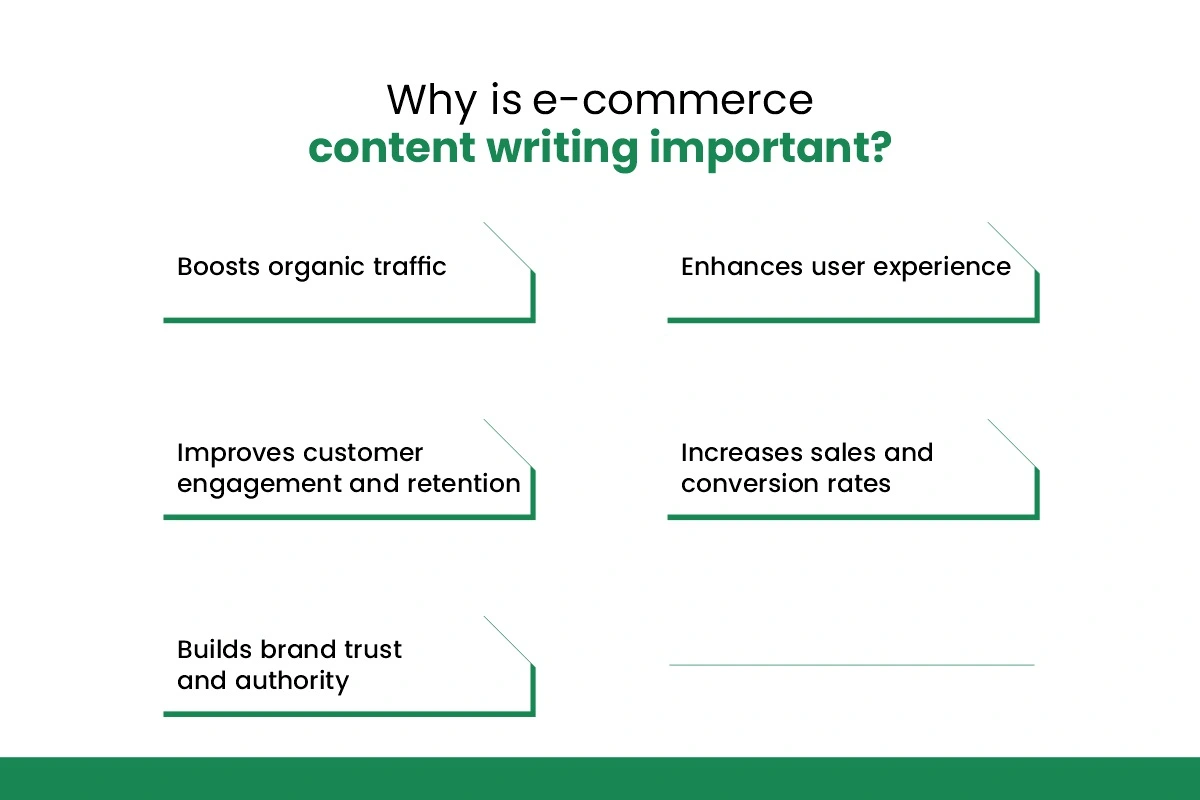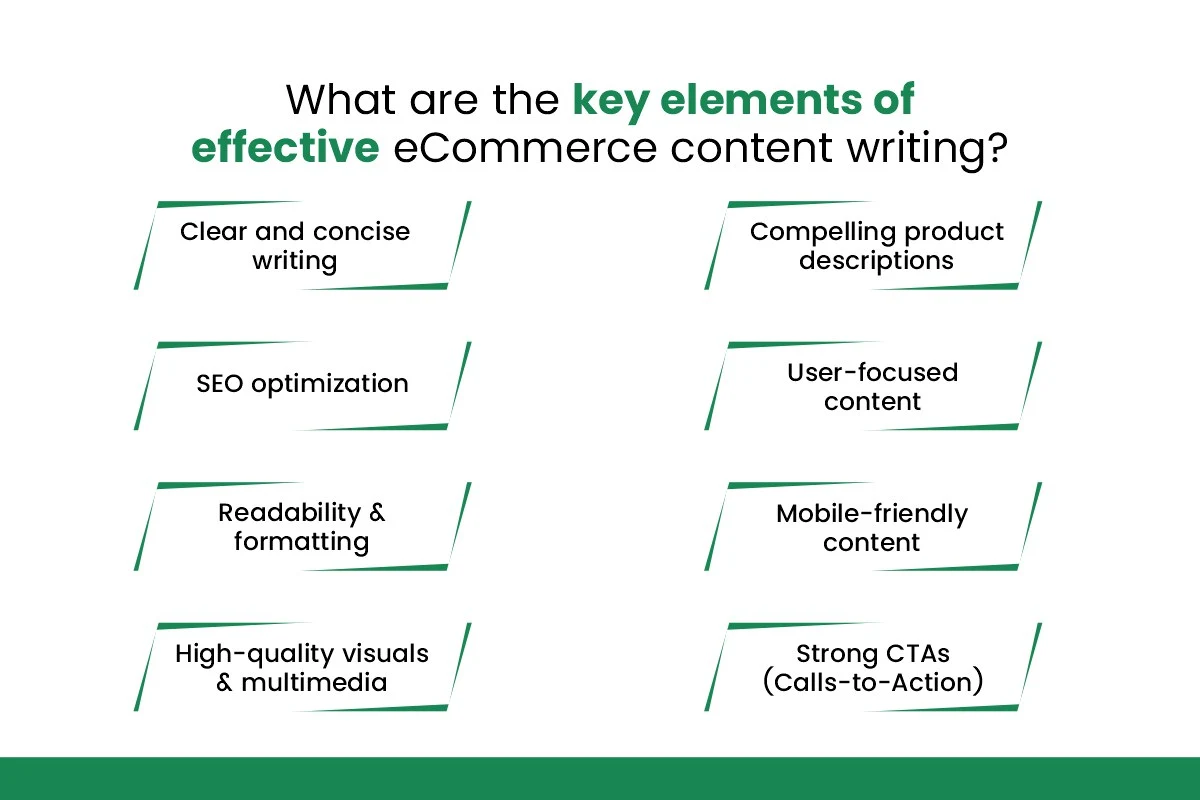#1 SEO Company Dubai
#1 SEO Company Dubai
Sun-Thu: 10 AM to 7 PM - Sat-Fri: Closed

Content writing for e-commerce platforms involves writing compelling information with a focus on search engine optimization (SEO) that enables online platforms to draw clients and turn them into customers.
The modern digital market demands high-quality content because it remains the key element businesses need to excel beyond their competitors. Your success as an online business depends heavily on your ability to master content creation, regardless of small business or a large eCommerce platform.
This blog will explore the fundamentals of eCommerce content writing, its importance, best practices, and how to optimize content for better conversions.
E-commerce content writing is the process of creating engaging, informative, and SEO-optimized content that helps online stores attract, engage, and convert customers.
E-commerce content serves a different purpose than regular content writing because it functions to draw customers who are potential buyers while delivering essential product information for improving search engine rankings and ultimately driving users to complete purchases. The best product descriptions avoid basic functional lists because they demonstrate advantages, demonstrate solution powers, and establish superiority against market competitors.
The development of clear and interesting eCommerce content leads to improved business expansion by boosting both online findability and maintaining customer faith, which results in sustained buyer loyalty.

The significant factors behind eCommerce content writing importance include:
E-commerce businesses meet their customers' needs through multiple forms of textual content, which
Here are 6 types of eCommerce content:
Deciding factors for customers appear in product descriptions, which demonstrate benefits along with features and uses. The right product description method introduces technical aspects while creating a narrative regarding the product’s role in people's day-to-day activities. Good descriptions use persuasive language, emphasize unique selling points, and address potential pain points of buyers.
Example: Instead of just saying “Water-resistant smartwatch with 7-day battery life,” write “Stay connected all week with a 7-day battery and track your swims with water resistance up to 50 meters.”
Category pages enable customers to browse clustered products and increase SEO performance through targeted keyword optimization, also simplifying navigation. Customers can reach their product goals more conveniently through these organized pages, which lead them to the appropriate selection without issues. An optimized category page starts with a brief yet intriguing segment that explains product category advantages, distinct features.
Example: The “Men’s Running Shoes” category could say, “Our line of lightweight shoes which provide cushioning and durability across all foot stride.”
Blogs and guides educate customers, improve SEO, and position brands as industry experts. Through their expert responses, customers get answers while obtaining solutions and complete insights about important product topics. Quality research-based blog articles drive natural website traffic while capturing customer interest and fostering buying intentions by showing an understanding of typical problems and suggesting valuable guidance.
Example: The blog post “How to Style Sneakers for Any Occasion” contains guide-like information that connects to prominent sneakers available for purchase.
Landing pages focus on producing conversions through direct promotion of product campaigns and special offers. The main purpose of landing pages differs from product pages because they aim to lead users toward one specific action like product buying or newsletter registration, or deal claiming. These pages combine fascinating headlines with impactful wording, charismatic CTAs, and powerful multimedia elements to stimulate users to act right away.
Example: A Black Friday landing page may say, “Limited-time 50% off—shop now before the deal expires!”
Emails serve to provide promotional announcements as well as strengthen customer relationships while promoting additional purchases from existing customers. Strategic email marketing practice requires personalized subject line design next to interesting content that uses explicit CTAs.
Example: A re-engagement email could say, “We miss you! Here’s 15% off your next order—use code WELCOME15.”.
Social media businesses produce content for posts and captions with ads that target audience interaction while boosting brand recognition to direct visitors who will visit their website. Evaluating target demographics allows companies to make platform-oriented content that keeps a unified brand identity.
Example: A skincare brand shows the transformation of skin appearance after using their Vitamin C serum throughout four weeks while adding the tag #GlowUp.
To produce high-quality e-commerce material, writers need clear documentation along with optimized SEO approaches that connect with their audience.

The following list contains the critical components that transform e-commerce content into an effective program.
To maximize online visibility, eCommerce content must be optimized for search engines. Implementing these eCommerce SEO strategies will help drive more organic traffic to your store:
Even well-established eCommerce businesses make content mistakes that can hurt their rankings and conversions. Here are some common pitfalls to avoid:
E-commerce content writing plays a crucial role in attracting customers, improving search rankings, and driving sales. A strong content strategy ensures that your online store provides valuable information and enhances the shopping experience, builds trust, and converts visitors into loyal customers.
By following best practices, avoiding common mistakes, and continuously optimizing your content, you can establish a strong online presence and maximize your eCommerce success. Start implementing these strategies today with BeinSEO, and watch your sales grow!
The best practices for writing product descriptions include using clear, concise, and persuasive language while incorporating relevant keywords and high-quality images.
Ecommerce blog content can be optimized by performing keyword research, using compelling headlines, incorporating internal links, and adding engaging visuals.
SEO is important for eCommerce content because it improves visibility, drives organic traffic, and increases conversions.
Ecommerce content should be updated every few months to maintain relevance, improve search rankings, and enhance user engagement.
The success of eCommerce content can be measured by tracking organic traffic, conversion rates, bounce rates, and engagement metrics.
© copyright 2023 OutOfBoxDesign